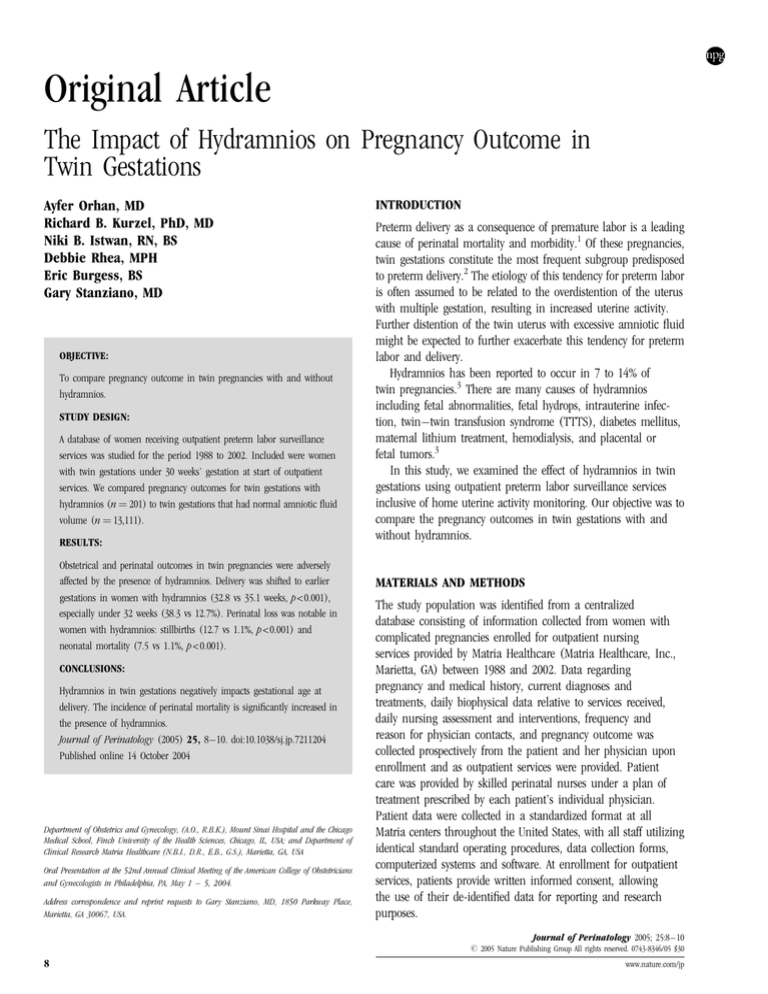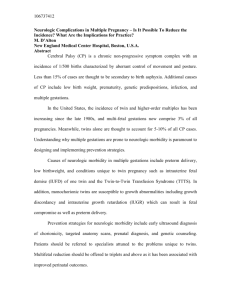
Original Article
The Impact of Hydramnios on Pregnancy Outcome in
Twin Gestations
Ayfer Orhan, MD
Richard B. Kurzel, PhD, MD
Niki B. Istwan, RN, BS
Debbie Rhea, MPH
Eric Burgess, BS
Gary Stanziano, MD
OBJECTIVE:
To compare pregnancy outcome in twin pregnancies with and without
hydramnios.
STUDY DESIGN:
A database of women receiving outpatient preterm labor surveillance
services was studied for the period 1988 to 2002. Included were women
with twin gestations under 30 weeks’ gestation at start of outpatient
services. We compared pregnancy outcomes for twin gestations with
hydramnios (n ¼ 201) to twin gestations that had normal amniotic fluid
volume (n ¼ 13,111).
RESULTS:
Obstetrical and perinatal outcomes in twin pregnancies were adversely
affected by the presence of hydramnios. Delivery was shifted to earlier
gestations in women with hydramnios (32.8 vs 35.1 weeks, p<0.001),
especially under 32 weeks (38.3 vs 12.7%). Perinatal loss was notable in
women with hydramnios: stillbirths (12.7 vs 1.1%, p<0.001) and
neonatal mortality (7.5 vs 1.1%, p<0.001).
CONCLUSIONS:
Hydramnios in twin gestations negatively impacts gestational age at
delivery. The incidence of perinatal mortality is significantly increased in
the presence of hydramnios.
Journal of Perinatology (2005) 25, 8–10. doi:10.1038/sj.jp.7211204
Published online 14 October 2004
Department of Obstetrics and Gynecology, (A.O., R.B.K.), Mount Sinai Hospital and the Chicago
Medical School, Finch University of the Health Sciences, Chicago, IL, USA; and Department of
Clinical Research Matria Healthcare (N.B.I., D.R., E.B., G.S.), Marietta, GA, USA
Oral Presentation at the 52nd Annual Clinical Meeting of the American College of Obstetricians
and Gynecologists in Philadelphia, PA, May 1 – 5, 2004.
Address correspondence and reprint requests to Gary Stanziano, MD, 1850 Parkway Place,
Marietta, GA 30067, USA.
INTRODUCTION
Preterm delivery as a consequence of premature labor is a leading
cause of perinatal mortality and morbidity.1 Of these pregnancies,
twin gestations constitute the most frequent subgroup predisposed
to preterm delivery.2 The etiology of this tendency for preterm labor
is often assumed to be related to the overdistention of the uterus
with multiple gestation, resulting in increased uterine activity.
Further distention of the twin uterus with excessive amniotic fluid
might be expected to further exacerbate this tendency for preterm
labor and delivery.
Hydramnios has been reported to occur in 7 to 14% of
twin pregnancies.3 There are many causes of hydramnios
including fetal abnormalities, fetal hydrops, intrauterine infection, twin–twin transfusion syndrome (TTTS), diabetes mellitus,
maternal lithium treatment, hemodialysis, and placental or
fetal tumors.3
In this study, we examined the effect of hydramnios in twin
gestations using outpatient preterm labor surveillance services
inclusive of home uterine activity monitoring. Our objective was to
compare the pregnancy outcomes in twin gestations with and
without hydramnios.
MATERIALS AND METHODS
The study population was identified from a centralized
database consisting of information collected from women with
complicated pregnancies enrolled for outpatient nursing
services provided by Matria Healthcare (Matria Healthcare, Inc.,
Marietta, GA) between 1988 and 2002. Data regarding
pregnancy and medical history, current diagnoses and
treatments, daily biophysical data relative to services received,
daily nursing assessment and interventions, frequency and
reason for physician contacts, and pregnancy outcome was
collected prospectively from the patient and her physician upon
enrollment and as outpatient services were provided. Patient
care was provided by skilled perinatal nurses under a plan of
treatment prescribed by each patient’s individual physician.
Patient data were collected in a standardized format at all
Matria centers throughout the United States, with all staff utilizing
identical standard operating procedures, data collection forms,
computerized systems and software. At enrollment for outpatient
services, patients provide written informed consent, allowing
the use of their de-identified data for reporting and research
purposes.
Journal of Perinatology 2005; 25:8–10
r 2005 Nature Publishing Group All rights reserved. 0743-8346/05 $30
8
www.nature.com/jp
Impact of Hydramnios on Twin Pregnancies
For this analysis, we identified women with twin gestations,
enrolled for outpatient preterm labor surveillance at a gestational
age of less than 30 weeks. The outpatient preterm labor
surveillance program included risk-assessment, patient education,
and twice-daily and PRN home uterine activity monitoring with
routine daily telephonic patient assessment and compliance
management by a perinatal nurse. Utilization of ambulatory
uterine activity monitoring for the early detection of preterm labor
was first described in 1986.4 Data were divided into two groups
based on a physician diagnosis of hydramnios (stated as ‘yes’ or
‘no’). Hydramnios was determined by the physician
ultrasonographically as an overall amniotic fluid index of over
25 cm.5,6 This diagnosis was reported by the physician’s office to
the Matria nurse during the referral and admission process and
input into the computerized database as a risk factor/condition
present at the start of outpatient services. Specific data such as the
exact amniotic fluid index, and chorionicity were not available for
analysis. We compared gestational age at delivery and neonatal
outcomes for women with twin gestations referred on admission
with hydramnios (n ¼ 201), to women with twin gestations that
had normal amniotic fluid volume (n ¼ 13,111) using Student’s
independent t and Fisher’s exact test statistics. An alpha level less
than 0.05 was considered statistically significant. SPSS for
Windows, version 12.0, was used for statistical analysis.
RESULTS
The maternal characteristics of 13,312 patients with twin
pregnancies enrolled in this study are summarized in Table 1. The
incidence of hydramnios at less than 30 weeks’ gestation in this
population was 1.5% (201/13,312). Patients with hydramnios were
less likely to be nulliparous (42.8 vs 50.2%, p ¼ 0.039) and more
likely to present with placenta previa (4.5 vs 1.7%, p ¼ 0.010).
Pregnancy outcomes are summarized in Table 2. The presence
of hydramnios was associated with a significantly earlier
gestational age at delivery as compared to twin gestations with
normal amniotic fluid volumes (32.8 ± 4.3 vs 35.1 ± 3.0 weeks,
p<0.001), and most significantly with higher rates of delivery at
under 32 weeks (38.3 vs 12.7%, p<0.001). Cesarean delivery was
more prevalent if hydramnios was present (71.1 vs 61.1%,
p<0.001).
Neonatal outcomes were decidedly negatively affected in twins
with hydramnios. NICU admissions were more common in twins
with hydramnios (63.5 vs 45.6%, p<0.001), as were lower birth
weights (1994 ± 678 vs 2305 ± 578 g, p<0.001), frequency of low
birth weight (76.0 vs 62.2%, p<0.001), number of small-forgestational-age infants (18.5 vs 7.2%, p<0.001), and a higher
neonatal death rate (7.5 vs 1.1%, p<0.001). A total of 35
pregnancies (17.4%) with hydramnios experienced at least one
stillborn infant, compared to 213 (1.6%) of pregnancies without
Journal of Perinatology 2005; 25:8–10
Orhan et al.
Table 1 Maternal Characteristics at Enrollment for Outpatient
Surveillance
Maternal age (years)
Nulliparous
Married
Tobacco use
Gestational age (weeks)
History preterm delivery
Cerclage
Vaginal bleeding*
Placenta previa
With
hydramnios
n ¼ 201
Without
hydramnios
n ¼ 13,111
p-Value
29.5±5.4
42.8%
84.1%
6.5%
25.3 ± 2.9
7.0%
5.5%
6.5%
4.5%
30.2±5.6
50.2%
85.2%
6.4%
25.6±3.0
9.5%
7.3%
4.4%
1.7%
0.097
0.039
0.626
0.884
0.078
0.276
0.411
0.166
0.010
Data presented as mean ± SD, or percentage as indicated.
*Unrelated to placenta previa.
Table 2 Pregnancy Outcome
Infants
Gestational age at
delivery
<35 weeks
<32 weeks
Cesarean delivery
Stillborn infants
Neonatal death
NICU/SCN admission
Small for gestational age
Mean % discordance
>25% discordance
With
hydramnios,
n ¼ 201
Without
hydramnios,
n ¼ 13,111
p-Value
n ¼ 402
32.8±4.3
n ¼ 26,222
35.1±3.0
<0.001
59.2%
38.3%
71.1%
12.7%
7.5%
63.5%
18.5%
16.8 ± 15.1%
24.9%
37.1%
12.7%
61.1%
1.1%
1.1%
45.6%
7.2%
11.2 ± 9.5%
8.3%
<0.001
<0.001
<0.001
<0.001
<0.001
<0.001
<0.001
<0.001
<0.001
Data presented as mean ± SD, or percentage as indicated.
hydramnios (p<0.001). The difference in the number of
pregnancies in which both twins were stillborn was statistically
significant (p<0.001). In 16 pregnancies complicated with
hydramnios (8.0%), stillbirth of both twins occurred while loss of
both twins was significantly less common in pregnancies without
hydramnios (83 with loss of both twins, 0.6%).
Discordance (>25%) was more often seen in twins with
hydramnios (24.9 vs 8.3%, p<0.001). In discordant pairs, a mean
discordance of 346 ± 343 g was observed in women with
hydramnios, while in discordant pairs with normal amniotic fluid
volume, the discordance was less (274 ± 244 g, p<0.007). As
discordance of >25% was most likely due to TTTS, we performed a
subgroup analysis to determine if the differences in pregnancy
9
Orhan et al.
Impact of Hydramnios on Twin Pregnancies
Table 3 Subgroup Analysis of Pregnancy Outcomes Without >25%
Discordance.
Infants
Gestational age at
delivery
<35 weeks
<32 weeks
Cesarean delivery
Stillborn infants
Neonatal death
NICU/SCN admission
Small for gestational age
With
hydramnios,
n ¼ 130
Without
hydramnios,
n ¼ 11,817
p-Value
n ¼ 260
32.9±3.4
n ¼ 26,634
34.4±2.7
<0.001
48.5%
25.4%
71.9%
3.8%
1.5%
54.3%
8.7%
34.8%
10.8%
60.6%
0.3%
0.2%
43.3%
5.1%
<0.001
<0.001
<0.001
<0.001
0.003
0.001
0.014
Data presented as mean ± SD, or percentage as indicated.
outcomes persisted after removal of this possible confounder.
Highly significant differences in pregnancy outcome remained as
shown in Table 3.
DISCUSSION
Hydramnios is a known risk factor for preterm labor and
delivery for both singleton and twin pregnancies. In both cases,
preterm labor is presumed to result from uterine overdistention,
with the stretching of the myometrium resulting in release of
prostaglandins that induces cervical softening and initiates labor.7
If hydramnios is associated with monozygotic twinning, it has been
speculated that excessive fetal urination in the hyperperfused
twin results in excretion of platelet-activating factor into the
amniotic fluid, which can stimulate uterine contractions.8
Hydramnios in twin pregnancies is most often seen with
monochorionicity with TTTS,9 but this has also been reported
in dichorionic pregnancies,10,11 as well as when one fetus has
congenital renal disease.12
There is no uniform convention in the literature to define
hydramnios in twin gestations, but Newman and Luke6 have
proposed a sonographically determined overall amniotic fluid index
of greater than 25 cm as defining hydramnios. In our database, the
presence of hydramnios was sonographically determined by each
reporting physician; however, unfortunately neither the actual
amniotic fluid index, nor the chorionicity from placental
pathologic analysis were reported, and hence were not available to
us. This is a weakness of the present study as we are unable to
stratify data by severity of hydramnios or etiology.
Varma et al.13 in a study of 135 pregnancies complicated with
hydramnios between 32 and 36 weeks noted that pregnancies
complicated by hydramnios had a higher incidence of preterm
delivery, fetal distress, low Apgar score, macrosomia, fetal
10
anomolies, perinatal mortality and admission to NICU. In the
present study, we compared the pregnancy and perinatal outcome
of 201 twin pregnancies with hydramnios diagnosed at less than 30
weeks’ gestation, to 13,111 twin controls. We have demonstrated
that while the incidence of hydramnios is low, its presence has a
significant negative impact on pregnancy outcome. In twin
pregnancies, hydramnios caused a shift to earlier gestational ages
at delivery with resultant lower birth weights, a greater number of
NICU admissions, and higher neonatal mortality. The observed
discordance in birth weight of twin pairs is significantly associated
with hydramnios, and is probably a result of the TTTS in most
cases.
In conclusion, hydramnios in twin gestations aggravates the
tendency for preterm labor and delivery. It is associated with an
increased risk of discordant growth, and perinatal and neonatal
mortality and morbidity.
References
1. Copper RL, Goldenberg RL, Creasy RK, et al. A multicenter study of preterm
birthweight and gestational age specific mortality. Am J Obstet Gynecol
1993;168:78–84.
2. Slattery MM, Morrison JJ. Preterm delivery. Lancet 2002;360:1489–97.
3. Kramer WB, Van den Veyver IB, Kirshon B. Treatment of polyhydramnios
with indomethacin. Clin Perinatol 1994;21:615–30.
4. Katz M, Gill PJ, Newman RB. Detection of preterm labor by ambulatory
monitoring of uterine activity: a preliminary report. Obstet Gynecol
1986;68:773–8.
5. Watson WJ, Harlass FE, Menard MK, et al. Sonographic assessment of
amniotic fluid in normal twin pregnancy. Am J Perinatol 1995;12:122–4.
6. Newman RB, Luke B. Multifetal Pregnancy. Philadelphia, PA: Lippincott,
Williams and Wilkins, Inc.; 2000.
7. Kleeck FK, Jung H. In vitro release of prostaglandins from the human
myometrium under the influence of stretching. Am J Obstet Gynecol
1973;115:1066–73.
8. Billah MM, Johnston JM. Identification of phospholipid platelet activating
factor in human amniotic fluid and urine. Biochem Biophys Res Commun
1983;113:51.
9. Pridjian G, Nugent C, Barr M. Twin gestation: influence of placentation on
fetal growth. Am J Obstet Gynecol 1991;165:1394–401.
10. King A, Soothill P, Montemagno R, et al. Twin-to-twin blood transfusion in
a dichorionic pregnancy without the oligohydramnios–hydramnios
sequence. Br J Obstet Gynecol 1995;102:334–5.
11. Rodriguez J, Porter H, Stirrat G, Soothill P. Twin-to-twin blood transfusion
in a dichorionic pregnancy without the oligohydramnios–hydramnios
sequence. Br J Obstet Gynecol 1996;103:1056.
12. Watson W, Munson D, Ohrt D, Carlson G, Rhodes R. Hydramnios–
oligohydramnios in a twin pregnancy complicated by fetal glomerulocystic
kidney disease. Am J Perinatol 1995;12:379–81.
13. Varma TR, Bateman S, Patel RH, Chamberlain GV, Pillai U. The
relationship of increased amniotic fluid volume to perinatal outcome. Int J
Gynaecol Obstet 1988;27:327–33.
Journal of Perinatology 2005; 25:8–10





